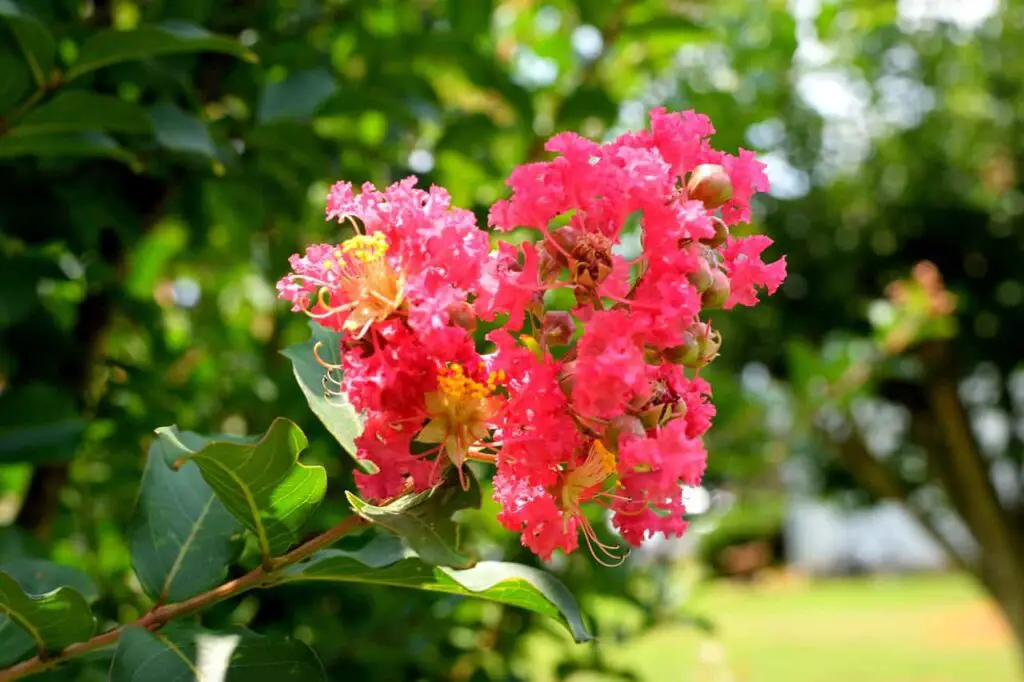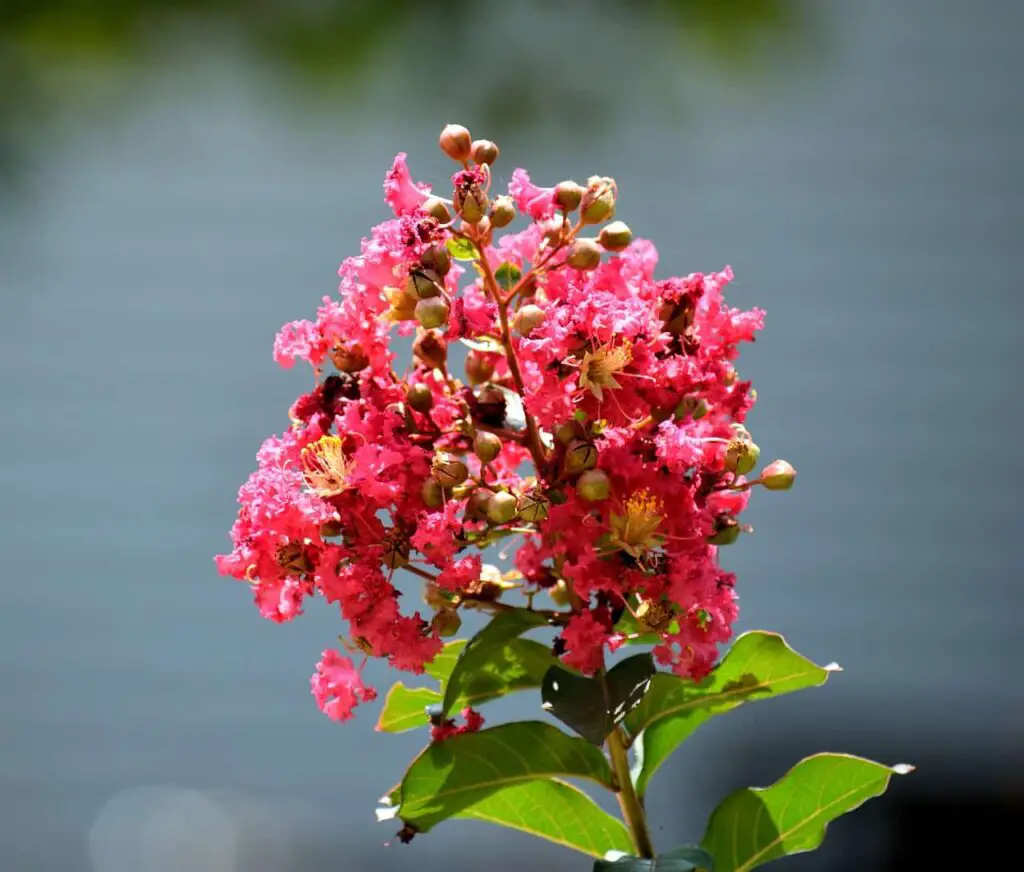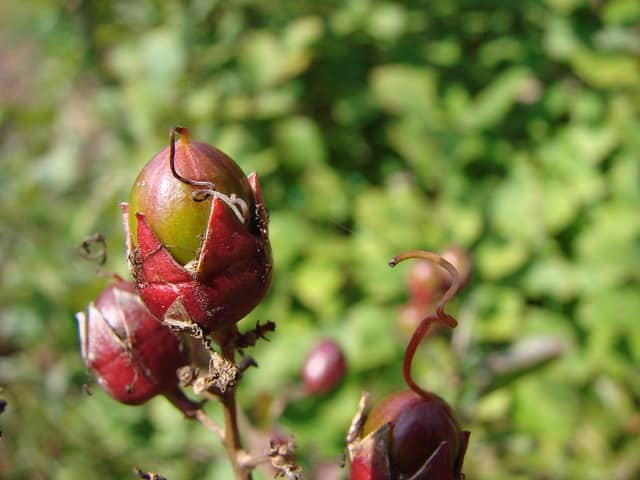Are you a Crepe Myrtle lover are wants to propagate it? But unsure about the best method? Rooting crepe myrtle in water is a popular and effective technique that allows you to grow new plants from cuttings. We will provide a step-by-step guide on successfully rooting crepe myrtle in water. From preparing the cuttings to transplanting them into the soil, we will cover everything you need to know.
One of the most successful propagation methods is rooting crepe myrtle cuttings in water. This technique offers a higher success rate than other methods and is relatively simple to follow.
Selecting the Right Tools and Materials

To successfully root crepe myrtle cuttings in water, you will need a few essential tools and materials:
- Sharp pruning shears or a clean knife
- Clean glass or jar
- Freshwater or filtered water
- Rooting hormone (optional)
- Perlite or vermiculite (optional)
These tools and materials will help create an ideal environment for root development and ensure the success of your propagation efforts.
Choosing Healthy Crepe Myrtle Cuttings
Choosing healthy, disease-free branches is important when selecting crepe myrtle cuttings for propagation. Look for young stems around 6 to 8 inches long with a diameter of approximately 1/4 to 1/2 inch. Avoid using old, woody branches as they are less likely to root successfully.
Preparing the Cuttings
Use sharp pruning shears or a clean knife to create an angled cut just below a leaf node to ensure proper cutting. Remove any flowers or buds from the cutting, as they can hinder root development by diverting energy away. Trim off the lower leaves, retaining only a few pairs of leaves at the top for optimal growth.
Rooting Crepe Myrtle in Water
Now that you have prepared the cuttings, it’s time to root them in water:
- Fill a clean glass or jar with fresh, room-temperature water.
- Apply rooting hormone at the lower end of each cutting to promote the roots.
- Place the cuttings in the water, submerging the bottom nodes while the upper leaves remain above the waterline.
- Find a suitable location for the glass or jar, such as a bright windowsill with indirect sunlight.
- Replace the water daily to maintain freshness and avoid mold or bacteria.
- Be patient and monitor the cuttings regularly. Within 6-8 weeks, you should start to see the roots grow.
Rooted Cuttings Monitoring and Care
Once the crepe myrtle cuttings have rooted in water, it’s important to provide them with proper care:
- Monitor the water level and change it regularly to maintain its freshness.
- Keep cuttings in indirect sunlight. Avoid direct sunshine, which can stress young plants.
- Maintain a consistent temperature around the cuttings, ideally between 65°F and 75°F (18°C and 24°C).
- Avoid overcrowding the glass or jar to allow proper air circulation around the cuttings.
- Mist the leaves with water occasionally to provide them with moisture.
Following these care instructions will ensure the health and growth of your rooted crepe myrtle cuttings.

Transplanting Rooted Cuttings into Soil
Once the roots of the crepe myrtle cuttings have started growing, it’s time to move them to the soil. First, prepare a well-draining pot or garden area. Then, Create a small hole and carefully place the rooted cutting in it. Press the soil around the cutting’s base to keep it firmly in place.
Be sure to thoroughly water the newly transplanted cutting and maintain moist soil without overdoing it. Place the pot or garden bed in a partially shaded area during the first few weeks to help the cutting adjust to its new environment.
Troubleshooting Common Issues
While rooting crepe myrtle in water is reliable, you may encounter some common issues.
- Suppose your cuttings don’t root. One possible reason will be you not changing the water regularly or using headwater. so try to change water regularly and use soft water.
- If mold or bacteria develop in the water, remove the affected cuttings, discard the water, clean the glass or jar, and start fresh.
- The leaves turning yellow or wilting may signal water issues. Consider utilizing rainwater or pond water as an alternative.
Remember that patience and attentive care are key to successful crepe myrtle propagation.
Enhancing Crepe Myrtle Growth
Ensure consistent watering, particularly during droughts. Administer a balanced, gradual-release fertilizer at the start of spring to furnish crucial nutrients. Put mulch around the plant’s roots to preserve moisture and restrain weed proliferation.
Winter Care for Crepe Myrtle
Crepe myrtle plants are generally hardy but may require some protection during winter in colder climates. Here’s how to winterize your crepe myrtle:
- Put a layer of mulch around the plant’s base to insulate the roots and keep the soil moist.
- Wrap the lower trunk with burlap or tree wrap to shield it from freezing temperatures and harsh winds.
- To safeguard from severe cold spells, use frost blankets or covers.
- Avoid pruning in late summer or fall, as it can stimulate new growth that is more susceptible to winter damage.
Pests and Diseases: Prevention and Treatment
Although usually resistant to pests and diseases, crepe myrtle can still face issues. Crepe myrtle plants face significant risks from Japanese beetles, aphids, powdery mildew, and leaf spot infections.
To prevent any problem, regularly inspect your plants for common pests and prune any infected branches. Additionally, use organic insecticides or horticultural oils as a preventive measure or to control infestations. Stay proactive and attentive to keep your crepe myrtles healthy.
Read More: – Easy Guide to Using Neem Oil for Garden Pest and Disease Control
Other Propagating Methored of Crepe Myrtle Options
Aside from rooting crepe myrtle in water. You can use various propagation methods, such as seeds, softwood, and hardwood cuttings.
Propagating from Seed

To propagate crape myrtle using seeds is an option for you. First, Collect the seeds from developed crape myrtle trees. The ideal time to sow the seed pods using Seedling Mix potting soil in late spring or early summer.
Patience is crucial during germination, which may take several weeks or even months before sprouting occurs.
It is recommended to keep the plant containers in a greenhouse or cover them with a large plastic bag to ensure they receive adequate heat and light.
During this stage, use a spray bottle to mist the soil with water, but avoid exposing it to direct sunlight until new growth emerges. Once established, these plants thrive in full sun and moderate moisture levels.
Propagating from Root Cuttings
To start, take root cuttings in late winter or early spring (July to August) when the plant is dormant. Cut six-inch lengths of the thickest roots of the parent plant and ensure each cutting has several nodes or buds.
After cutting, transfer the cuttings to a receptacle filled with moist soil and store them in a shaded and cool spot until they develop new shoots.
Propagating From Cuttings
- First, identify healthy shrub sections with new growth and include a bud near a main branch’s crotch. Propagation through cuttings is most effective during the growing season, usually between June and August.
- Using sharp shears, make a clean cut at an angle below a node and strip any foliage from the lower half of the cutting.
- Ensure that the cuttings are about 6 inches long, have nodes with leaves, and lack flowers/buds.
- Immerse the lower end of the stem into a rooting hormone mixture. And insert it into moist soil or rooting beds filled with peat moss. Keep your planting medium moist but not wet, and place it in partial sun or bright light until roots develop.
- After root development, transfer it to a permanent location. Depending on the cultivar, ensure the spot gets full or partial sun.
- Prune the new growth, using shears to promote and remove suckers or dead wood. Mulch around the base crape myrtle tree during the fall and winter months to protect it from drought conditions.
Propagating With Softwood Cuttings
Softwood cuttings are a great way to propagate new crepe myrtle shrubs. Select young cuttings with two sets of leaves and dip them in the rooting hormone to get started.
Place them in a container filled with water and change the water every few days for optimal moisture levels.
After roots form about an inch long, plant them in good potting soil with partial sun exposure. This easy way of propagation is perfect during the summer months.
Propagating With Semi-Hardwood Cuttings
Propagating Crepe Myrtle can be done through seedlings or root cuttings. However, using semi-hardwood cuttings is an easy way to have new plants for the gardener. Late summer is the best time to do this when the plant is growing.
This method involves cutting from a mature crepe myrtle tree and encouraging it to grow roots in the soil.
- To start, select a healthy branch from your crepe myrtle tree that is roughly 6-8 inches long and has a 1/4 to 1/2 inch diameter.
- Cut at a 45-degree angle just below a bud or node.
- Remove all leaves of the cutting, except two or three that should be at the top.
- Next, apply rooting hormone powder to the end of the cutting.
- Then, insert the cutting into a container filled with moist soil, ensuring the leaves are above the soil line.
- To make a greenhouse, Wrap the receptacle with a plastic bag.
- Put the container under indirect sunlight. Direct sunlight can burn leaves and hinder development.
- After a few months, check whether it has grown its roots.
- Transfer the cutting to a bigger container or your garden soil when it develops roots.
Read More: – How to Repot a Plant with Root Rot – a Step-by-Step Guide
Conclusion
Propagating Crepe Myrtle can be done in different methods, and rooting crepe myrtle in water is effective and simple. You can grow crepe myrtle cuttings and expand your collection with that information.
It is important to monitor the progress of the cuttings and only transfer them to the ground once their roots have fully developed. This will ensure successful growth and establishment in their new environment. Your garden will be rewarded with stunning crepe myrtle flowering plants by exercising patience and giving proper attention.

